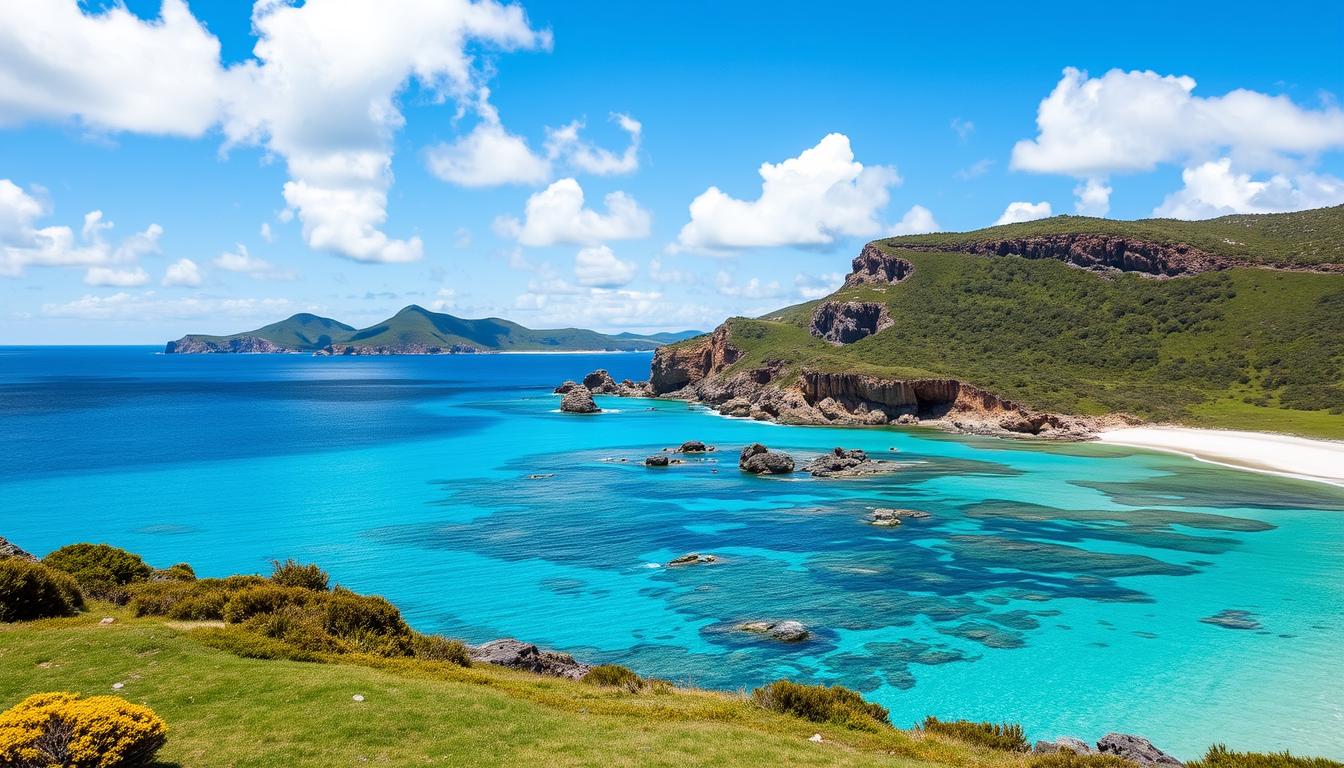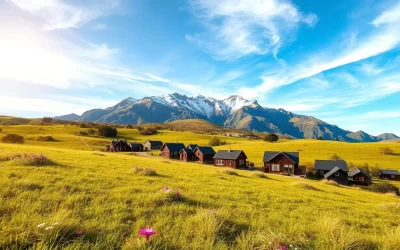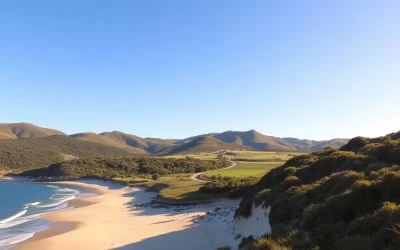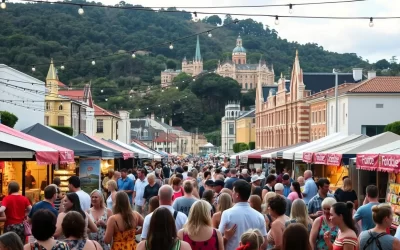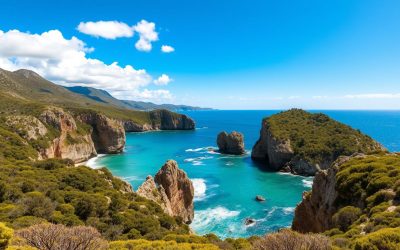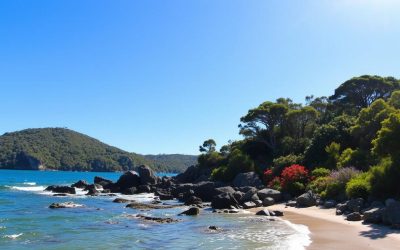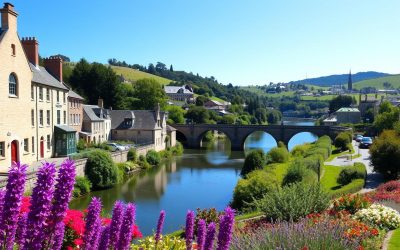Are you ready to find a hidden Tasmanian paradise? Here, history, wildlife, and stunning landscapes come together. Maria Island is waiting for you, offering an adventure unlike any other.
Maria Island National Park is a gem off Tasmania’s east coast. It’s a car-free island filled with natural wonders and history. You’ll dive into untouched wilderness, meet unique wildlife, and explore convict heritage.
Your journey starts with a scenic 30-minute ferry ride from Triabunna. You’ll enter a world unlike any other. From ancient cliffs to Forester kangaroos, every moment is special on Maria Island.
Key Takeaways
- Explore a UNESCO World Heritage-listed national park
- Encounter unique Tasmanian wildlife in their natural habitat
- Discover fascinating convict-era historical sites
- Enjoy affordable ferry tickets starting at $28
- Experience pristine, car-free natural landscapes
Introduction to Maria Island National Park
Explore the stunning Maria Island National Park, a hidden gem off Tasmania’s east coast. It offers a unique blend of natural wonders, rich history, and wildlife adventures.
Since 1972, Maria Island has been a national park. It’s a mix of nature and history. The island is 115.5 square kilometers big, ready for you to discover.
Location and Geography
Maria Island is just 4 kilometers off Tasmania’s east coast. It has:
- 20 kilometers long from north to south
- 13 kilometers wide at its widest point
- It has rugged cliffs, beautiful bays, and green forests
Getting to Maria Island
Getting to Maria Island is easy. Start with a scenic ferry ride from Triabunna. It takes about 30 minutes. This ride opens the door to natural beauty and history.
Best Time to Visit
The best time to visit is during Tasmania’s summer (December-February). The weather is perfect for hiking and wildlife watching. Each season offers something special:
- Summer: Warm weather, lots of wildlife
- Autumn: Mild weather, beautiful colors
- Winter: Quiet, great for wildlife spotting
- Spring: Wildflowers bloom, perfect for bird watching
“Maria Island is not just a destination, it’s a journey through time and nature.” – Tasmanian Parks Service
The Rich History of Darlington Settlement
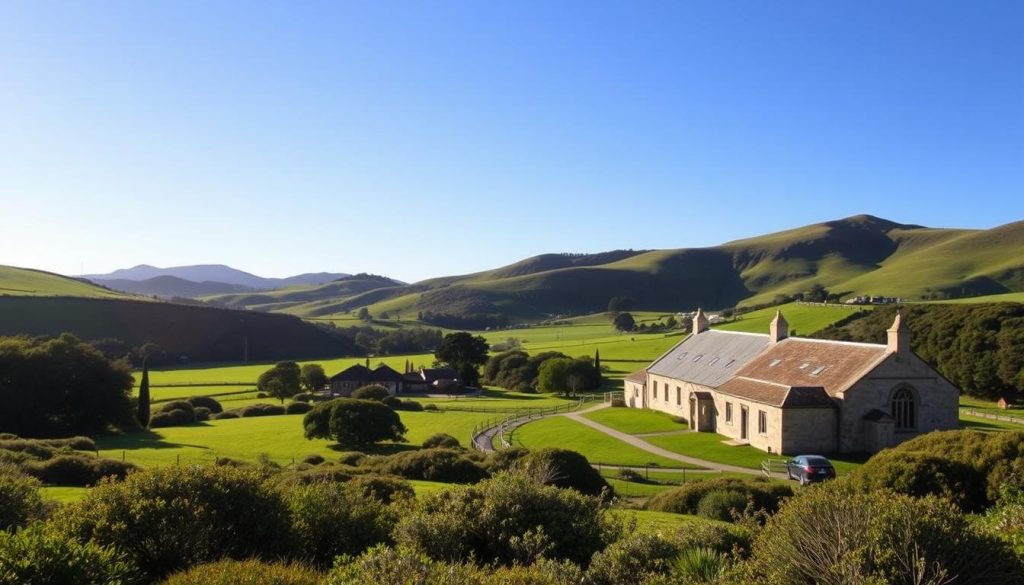
Maria Island has a long and fascinating history. It shows the stories of Aboriginal people, convict life, and industrial growth. Dutch explorer Abel Tasman found the island in 1642, starting a journey of change.
The Tyreddeme ban by the Oyster Bay Aboriginal tribe marked the island’s early days. Their legacy lives on through archaeological finds. The arrival of Europeans brought big changes to the island.
“Maria Island is a living museum of Tasmania’s rich and complex historical landscape.”
- First convict period: 1825-1832
- Second convict period: 1842-1851
- Significant industrial development: 1920 cement works establishment
Darlington became key during the convict era. The Commissariat Store, built in 1825, now welcomes visitors. It tells the story of Maria Island’s tourism heritage. The Convict Penitentiary, finished in 1828, reminds us of the island’s tough past.
| Historical Period | Key Development |
|---|---|
| 1805-1830s | Seal hunting and whaling industries |
| 1920s | Cement works establishment |
| Late 1960s | Transition to national park |
Over time, the island’s economy changed from hunting to farming and then to conservation. By 1971, it became a national park. This move protected its history and nature for future visitors.
Wildlife Encounters and Natural Sanctuary
Maria Island is a magical place for wildlife viewing. It’s a chance to see Tasmania’s iconic creatures up close. This national park is perfect for seeing native animals in their home, making it a top spot for outdoor fun.
As the sun sets, the island comes alive. Tasmania’s unique ecosystem supports many animals. They call this sanctuary home.
Native Animals to Spot
On Maria Island, you can see many special animals:
- Wombats roam freely across grasslands
- Bennetts wallabies hop through beautiful landscapes
- Pademelons graze in quiet meadows
- Forester Kangaroos roam open areas
- Tasmanian Devils explore at dusk
Bird Watching Opportunities
Birdwatchers will love Maria Island. It’s known as an Important Bird Area by BirdLife International. The island is home to many endemic and migratory species.
Marine Life Exploration
The waters around Maria Island are full of marine life. They add another layer to your adventure.
“Maria Island is not just a destination; it’s a living, breathing wildlife sanctuary where nature reveals its most intimate moments.” – Tasmanian Wildlife Conservation Society
| Animal | Average Size | Viewing Best Time |
|---|---|---|
| Tasmanian Devil | 65 cm long | Dusk |
| Eastern Grey Kangaroo | 2 m tall | Early morning/evening |
| Bennett’s Wallaby | 90 cm tall | Dawn and dusk |
Always watch wildlife from a distance. This helps keep them safe and their home intact during your visit.
Maria Island, Tasmania: Best Things to Do – Top Picks
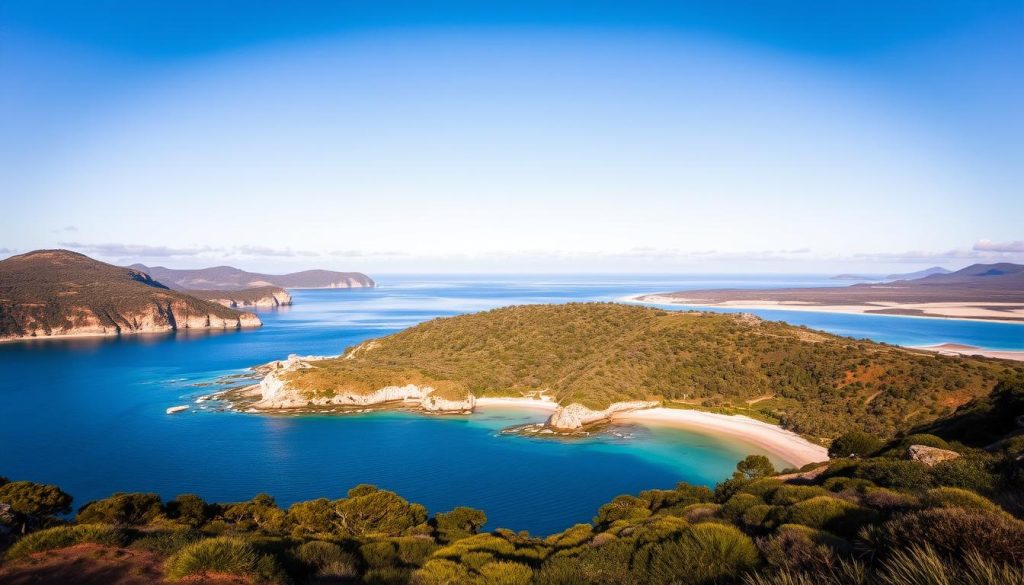
Explore the best of Maria Island for an unforgettable Tasmanian adventure. This national park has something for everyone, from nature lovers to history enthusiasts.
“Maria Island is a paradise where wilderness meets history, offering visitors a unique blend of natural beauty and cultural significance.”
Here are the top activities to enjoy on Maria Island:
- Hiking and Walking: Discover scenic trails like Bishop and Clerk Track
- Cycling: Rent a bike and explore the island’s car-free landscape
- Wildlife Watching: See wombats, Tasmanian devils, and rare birds
- Swimming and Snorkeling: Enjoy the island’s beautiful beaches and clear waters
- Historical Tours: Learn about the island’s convict history
Planning your Maria Island trip? Here’s a helpful guide:
| Activity | Difficulty | Duration |
|---|---|---|
| Bishop and Clerk Track | Challenging | 4-5 hours |
| Painted Cliffs Walk | Easy | 1-2 hours |
| Wildlife Viewing | Easy | Flexible |
| Snorkeling | Moderate | 2-3 hours |
Getting to Maria Island is easy. A 30-minute ferry ride from Triabunna costs $54 per adult. It’s a great way to see Tasmania’s natural beauty.
Exploring the Fossil Cliffs and Painted Cliffs
Maria Island is home to two amazing sights: the Fossil Cliffs and the Painted Cliffs. These wonders show off the island’s rich history and offer stunning views. They are must-sees for anyone visiting.
The Fossil Cliffs are like a time machine to the past. This 4-kilometer trail is filled with fossils from 300 million years ago. You’ll see fossils of clams, scallop shells, sea fans, corals, and sea lilies.
- Clams
- Scallop shells
- Sea fans
- Corals
- Sea lilies
Exploring the Fossil Cliffs is easy thanks to a flat path. It’s great for most visitors. The walk takes about 2.5 hours, but you can do it in one hour if you’re quick.
“These cliffs are a living museum of marine life from millions of years ago” – Local Geologist
The Painted Cliffs are right next to the Fossil Cliffs. They show off amazing colors and patterns from the ground and sea. The hike is 4.4 kilometers and takes about 45 minutes to an hour.
Tip: Go during low tide for the best views of the Painted Cliffs. Bring your camera because these sights are perfect for photos!
Hiking Trails and Walking Adventures
Maria Island is a paradise for hikers, with over 2,800 km of trails. It’s perfect for all skill levels and adventure lovers. You’ll find amazing Maria Island hiking trails here.
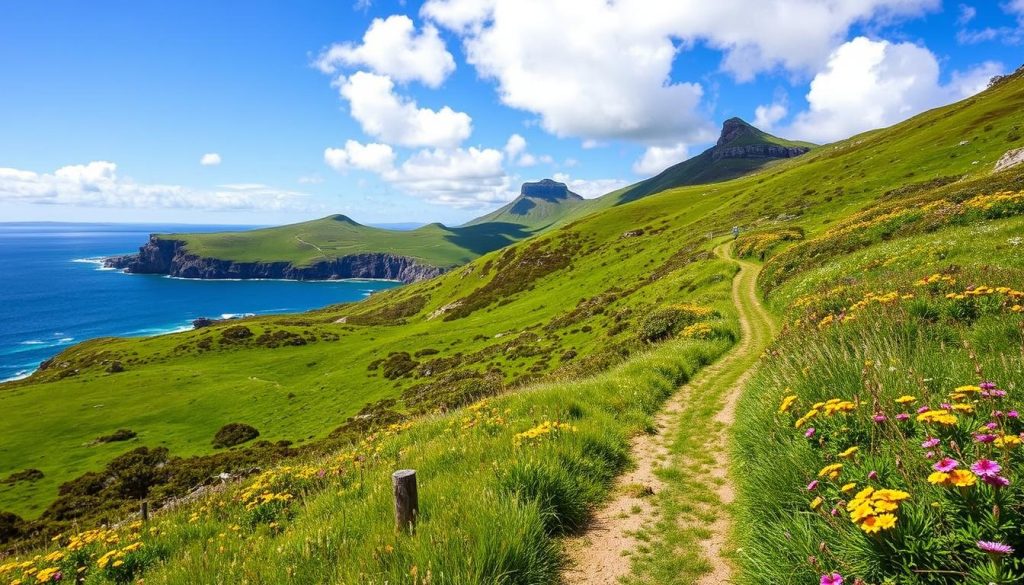
Get ready for an unforgettable walk on Maria Island. The trails take you through different landscapes. You’ll see stunning views and meet unique wildlife.
Bishop and Clerk Track
The Bishop and Clerk Track is a top choice for hikers. It’s a tough trail that takes 3-5 hours to complete. You’ll face:
- Steep grassland traverses
- Woodland pathways
- Cliff-top panoramic views
- Elevation reaching 620 meters above sea level
Mount Maria Summit Walk
The Mount Maria Summit Walk is for the brave. It’s a tough hike that reaches 711 meters high. You’ll get:
- Spectacular island perspectives
- Varied ecological zones
- Potential wildlife sightings
Reservoir Circuit
The Reservoir Circuit is great for beginners. It’s a gentle trail that’s easy to follow. You’ll see:
- Moderate difficulty level
- Scenic water views
- Accessible terrain
“Lace up your boots and embrace the wild beauty of Maria Island’s landscapes!” – Local Hiking Guide
Don’t forget to bring water, snacks, and the right clothes. March and April are the best months to hike. The weather is nice, and there are fewer people around.
Cycling Around the Island
Maria Island is a cyclist’s dream, offering a unique way to see its beauty. Its small size makes it easy to explore by bike. You’ll find hidden spots and diverse landscapes as you pedal.
- Bike rental costs $33 per day for adults
- Children’s bike rental is available for $20 per day
- Bring water, snacks, and sun protection
- Check bike condition before departing
Popular routes include Darlington and the island’s varied terrain. You’ll see stunning coastlines, historic sites, and wildlife.
| Cycling Route | Distance | Difficulty |
|---|---|---|
| Darlington Settlement Loop | 8 km | Easy |
| Fossil Cliffs Trail | 12 km | Moderate |
| Painted Cliffs Expedition | 15 km | Challenging |
“Cycling on Maria Island is not just transportation—it’s an immersive journey through natural beauty and historical landscapes.”
Always respect the environment and follow trails. Enjoy the unique experiences that make Maria Island special.
Accommodation Options and Camping
Planning your stay on Maria Island is unique. Your accommodation choices are rustic and tied to the island’s history.
Maria Island camping gives you a special experience. You can pick from two main types of stays that show off the island’s charm:
Historic Penitentiary Accommodation
The Penitentiary is a standout place to stay. It lets you see Tasmania’s convict past up close. With 9 rooms and 6 beds each, and one room for 14, you can sleep in history.
- No electricity in rooms
- Shared bathroom facilities
- Community cooking areas
- Hot showers available
Camping Locations
For a natural camping experience, Maria Island has great spots:
| Camping Site | Distance from Darlington | Water Availability |
|---|---|---|
| Darlington | Base Location | Excellent |
| Frenchs Farm | 11-14 km | Plentiful |
| Encampment Cove | 14-16 km | Good |
| Robeys Farm | 16-18 km | Consistent |
Don’t forget to check in at the park office before camping. Sites fill up fast in December and January.
Pro tip: Bring lightweight gear and pack smart – there’s a 7 kg weight limit for bags transported to the island.
Your camping trip on Maria Island will be unforgettable. It connects you with Tasmania’s wilderness and history.
Historical Buildings and Convict Heritage
Maria Island is a key part of Australia’s convict history. It offers a deep dive into the past, showing the stories of early settlers and convicts.
The Darlington Probation Station is a UNESCO World Heritage site. It has 14 convict buildings and ruins left standing. These structures show the tough times of Tasmania’s colonial era.
“Every stone and structure on Maria Island tells a story of human resilience and survival.” – Local Historian
Some important historical buildings you’ll see include:
- Commissariat Store
- Coffee Palace
- Penitentiary Building
- Roman Catholic Chaplain’s House
Visiting Maria Island gives you a close look at convict life. The island’s efforts to preserve history let you see what life was like for early settlers. You’ll learn about their struggles and how they adapted.
| Building | Historical Significance | Current Status |
|---|---|---|
| Commissariat Store | Supplies distribution center | Preserved historical site |
| Penitentiary | Convict housing | Maintained archaeological site |
| Coffee Palace | Social gathering point | Restored historical building |
About 50% of UNESCO-recognized Australian convict sites are in Tasmania. Maria Island is a key place to learn about this important time in history.
Beach Activities and Swimming Spots
Maria Island is a paradise for beach lovers. Its coastline is untouched, offering clear waters and marine life perfect for swimming and discovery.
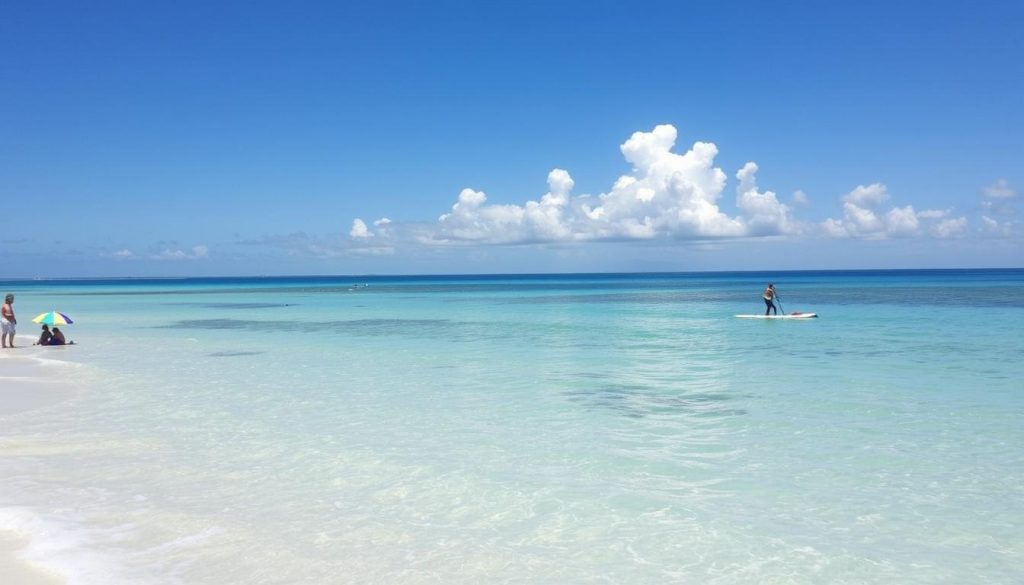
Looking for the best beaches on Maria Island? Here are some top picks:
- Shoal Bay: Perfect for gentle swimming
- Darlington Beach: Ideal for snorkeling
- Fossil Cliffs Beach: Scenic swimming spot with historical backdrop
- Painted Cliffs Beach: Unique geological formation with calm waters
It’s important to stay safe while swimming on Maria Island’s beaches. Watch out for marine life and check the weather before you dive in. The visibility around Tasmania’s coastal areas can range from 10 to 40 metres depending on the season, making it great for underwater adventures.
“Maria Island’s beaches are nature’s ultimate playground, combining pristine waters with breathtaking landscapes.” – Local Tourism Guide
| Beach | Activities | Best Season |
|---|---|---|
| Shoal Bay | Swimming, Sunbathing | Summer |
| Darlington Beach | Snorkeling, Marine Life Observation | Late Spring/Summer |
| Fossil Cliffs Beach | Photography, Exploring | Year-round |
Summer is special on Maria Island’s beaches. You might see bioluminescence from plankton, making your visit even more magical.
Conclusion
Maria Island tourism offers a unique escape with natural beauty, wildlife, and history. Your trip here will create lasting memories. You’ll see Tasmanian Devils, pristine beaches, and scenic trails, making it a top adventure spot.
When planning your visit, remember to pack the right gear. Bring comfortable shoes, a camera, and a sense of curiosity. The island’s trails, over 30 kilometers long, are perfect for exploring its varied landscapes. With over 100,000 visitors each year, you’ll join a community of adventurers.
Wildlife lovers will enjoy seeing Tasmanian species up close. The island protects wombats, kangaroos, and rare birds in their homes. Summer temperatures are perfect for exploring, with a lively atmosphere that shows off Tasmania’s wild side.
Before you go, remember to care for the environment and respect the island’s history. Your visit helps keep this special place safe for others to enjoy. Maria Island is more than a place to visit; it’s a journey that changes how you see nature and conservation.
The above is subject to change.
Check back often to TRAVEL.COM for the latest travel tips and deals.
